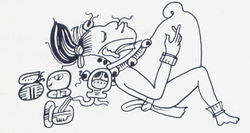User:Devink/sandbox9
Kelem Winik Pop | |
 Depiction of the Fat God, patron god of Comedy, Entertainment, Theatre, and Sumo | |
 | |
| Formation | December 28, 1941 |
|---|---|
| Headquarters | Hunpik K'o K'uhnah |
| Location | |
Region served | Mutul |
Membership | 208 |
Official language | Mutli |
Chairman | K'okol Hun Xiu |
The Strong Man Court or Court of the Strong Men (Mtl:కెలెమె వినికి పొపొ) is the body that operates and controls professional sumo wrestling in the Divine Kingdom. Contrary to its Tsurushimese counterpart, salaries of the Kelem Winikob, Referees, Helpers, and various other personnels aren't under the Court's payroll. Instead, salaries are left to the discretion of each individual stable, generally to be negociated before the signature of a contract. The Court, however, has jurisdiction over conflicts that could appear concerning solely sumo stables, be it about the salaries, the contracts, mismanagement of the establishment, tensions between wrestlers, and so on. It is also its responsability to organize the "Nine Divine Tournaments" of the Mutul and international competitions or showmatches with other Sumo organizations. The organisation is run entirely by the Elders of the 87 constituent stables. The organization has its headquarters in the northern wing of the Hunpik K'o K'uhnah, the Thousand Masks Temple, in K'alak Muul. The Temple is also the main center of formation of God Impersonators and other traditional entertainers of the Divine Kingdom.
History
The Mutuleses first came into contact with Sumo after they established the Mutulese Legation in Tsurushima. At the time, professional sumo groups existed, as entertainers for the Tsurushimese Upper class. The rules of the sport were already quite similar to their modern form, but tournaments didn't have champions, the score of the rikishi weren't tracked, and their promotion depended more on their popularity than their performances. Rikishi quickly became part of the distractions that could be offered in the Legation as simple show matches were organized within the district.
In 1608, a Mutulese trader convinced two Rikishi to follow him back to the Mutul. There, they held show matches and public display of the sport in Yu before moving across to K'alak Muul where they performed a match for the K'uhul Ajaw and his court.
In 1623, three veteran rikishi and their retainers were convinced to move to the Divine Kingdom to establish their own schools. They received recognition as Aj K'in and their establishments were officially recorded as Temples, as were other martial arts training facilities in the Mutul. The first real sumo tournament of the Mutul was held the next year in Yu between all three champions. The next tournament would be held in K'alak Muul 5 years later, and involved all of the Masters and their disciples, now fully trained.
Sumo would continue to slowly develop until the period of intense change that was the Itzamnaaj Reformation. Multiple structures began to appear with the aim to structure the sumo scene. By the 1880s, these had coalesced into two competing Courts: one based in Yu, the other in K'alak Muul. They would remain separated until the Tsurushimeses sumo elders created their own, nationwide association in the wake of the Daitoa Revolution. Inspired to create a true national body capable of handling the management of larger competitions and capable of representing the Divine Kingdom at the international, the Mutuleses elders of both courts spent decades in negociations that ultimately led to the successful merging of both organizations into the modern Pop in 1941.
Rules and Customs
Fighters
Sumo is a sport reserved to men in the Mutul. Kelem Winikob, direct translation of the Tsurushimese "力士", "Strong Man", are not divided by weight categories but by their ranking which track their scores in the annual Nine Divine Tournaments and other regional competitions. A Kelem Winik can participate in official competitions from 14 to 50 years old, after what he is forced to retire.
Like in Tsurushima and Enyama, all wrestlers take a wrestling name but they do not follow the same rule. The names recorded by the Strong Man Court are in Glyphic, not in Kanji and it is considered acceptable to pronounce or translate the Glyph directly into any other language, although Mutli or Tsurushimese are preferred.
Stables
All professional wrestlers have to be part of a "Stable". In the Mutul, these are known as Temples (ఖున, K'uhnah) and there are officially 87 of them as of 2020. A Kelem Winik, live and train within his Temple.